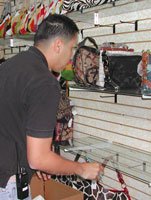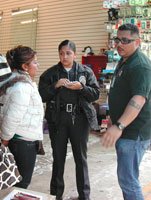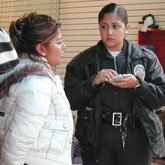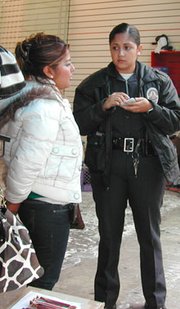Keeping Counterfeiters on Their Toes
Private investigators and police target L.A.’s copycat sellers
Inside the dowdy downtown police parking garage, Kris Buckner leafs through a thick three-ring white plastic notebook that could easily be considered the official guide to the Los Angeles counterfeiting world.
Page after page bears images of men, women and even teens suspected of selling every kind of cheap imitation imaginable, from bags and blue jeans to watches and wallets.
As Buckner, president of Investigative Consultants, rapidly shuffles through the pages, he zeroes in on today’s targets: two women and one man believed to be selling fake purses, jewelry and clothing at three different locations on Santee Alley, a four-block zone in Los Angeles’ Fashion District where merchandise is sold in open-air stalls sandwiched in between the back entrances of retail stores and wholesale showrooms.
“All three people have prior histories. They’ve already been served with cease-and-desist orders before,” notes Buckner, dressed in an oversize jacket and loose-fitting jeans and sporting a week’s growth of facial hair. The only clue to his true identity is the plastic badge looped around his neck with his photo and one simple word: “investigator.”
Buckner and his team of six men pile into two sturdy vans while four police officers climb into their black and whites to provide backup for today’s counterfeit raid in Santee Alley on Feb. 22.
While Buckner and his group zoom in on their suspects, Los Angeles Police Officer Randy McCain and his colleagues hang back in their squad cars, waiting for the call. Within a few minutes, Buckner alerts them that the targets have been apprehended selling counterfeit goods.
McCain and the three other officers— Tracy Allen, Juan Hernandez and Lupita Sanchez—hurry as fast as they can. “When we do the alley, we have to get to the location in 15 seconds,” McCain says, noting that vendors of counterfeit clothing and other items bolt as soon as they see anyone in a uniform coming down the alley jammed with shoppers.
Buckner and his colleagues have nabbed two women who allegedly are selling counterfeit purses and other fake items. A third suspect got away. The women are handcuffed and taken to the LAPD’s Central Division station at Sixth and Maple streets, where they will be booked and released on bail.
Buckner and his team start bagging the counterfeit items, which will be used as evidence to prosecute the women. Several other vendors, in fear of being arrested, bolted from their small stands, which cost as much as $600 a month for a small patch of real estate in front of a store. What is left behind—hundreds of fake purses, wallets, jewelry, T-shirts, CDs and DVDs—will be bagged with the other confiscated goods.
Authorities with the Los Angeles Fashion District note that the few bad apples on the alley give the market a bad name. “The large majority, and I am talking 90 percent and plus range, are selling legitimate merchandise,” said Kent Smith, executive director of the Fashion District Businesss Improvement District. “It is unfortunate that we have a number of people who persist in selling these things.”
Finding the fakes
Counterfeiting in Los Angeles is big business. The city’s industries are harder hit than most across the country because this is the nation’s entertainment capital as well as a major fashion capital.
The Los Angeles County Economic Development Corp. has calculated that copies of clothing, purses, shoes, watches, jewelry, compact discs, DVDs, toys, medicine and other items cost Los Angeles County businesses $5 billion a year and drain the economy of 100,000 jobs. Some $617 million of those fakes are attributed to clothing, shoes and accessories.
Nationwide, that figure mushrooms to more than $250 billion a year, with counterfeit clothing accounting for a good portion.
To combat the pervasive crime, Los Angeles last year formed a multi-agency Anti- Piracy Task Force to make a long-term effort to combat knockoff artists selling fake goods. Their first target was Santee Alley, where some 50,000 items worth more than $8 million were seized and 26 people were arrested on Nov. 29.
Another raid in January at the El Faro/Alameda Swap Meet near downtown Los Angeles resulted in 10 people being arrested for selling fake brand-name vitamins, blue jeans, jewelry, CDs and DVDs, said Detective Rick Ishitani of the LAPD’s vice squad.
The task force is taking a three-pronged approach to counterfeit crime, said Ben Golombek, a spokesperson for Los Angeles Councilmember Wendy Greuel, who heads the task force.
The first step is to educate the public that buying counterfeit items is bad and aids gang members, terrorist groups and criminals. Also on the education list are Los Angeles County’s Superior Court judges, who are learning how counterfeiting affects the economy and why stiffer sentences and fines are needed.
The second step is enhanced enforcement and more raids, Golombek said, so criminals realize the police and sheriff’s departments are taking these crimes seriously.
The third step is looking at changing policies toward counterfeiting, perhaps rewriting the city nuisance abatement ordinance that covers prostitution and drug sales to include counterfeit vendors.
Meanwhile, police continue to work with counterfeit investigators such as Carlos Fernandez, president of the Intellectual PropertyEnforcement Co., a Pasadena, Calif., business with several apparel company clients, and Buckner, who counts 50 apparel clients among his 90 customers at his Lawndale, Calif., company.
Over the years, Fernandez and Buckner have seen counterfeiters become more sophisticated and smarter.
“Fifteen to 18 years ago, counterfeit clothing wasn’t as complicated. They were basic, silk-screen embroidery products produced locally,” Fernandez said. “Consumers were happy with that level of counterfeiting. But nowadays, on all levels, the counterfeit merchandise is very complicated. It is almost identical-looking to the authentic merchandise. Because of that, a lot of apparel companies have had to implement security measures, such as a security thread, security stitching or a hologram that has all these security markings.”
Years ago, Ishitani, of the LAPD’s vice squad, observed that Levi’s was a popular knockoff brand. Now fake purveyors prefer True Religion, 7 For All Mankind, LRG and Rock & Republic denim labels, which sell for more than $150 a pair on the regular market, he said. Counterfeit jeans sell for around $40.
That rings true for Deborah Greaves, the attorney who heads up True Religion’s anti-counterfeit efforts. “We have developed a nationwide network of people like Kris Buckner who have years on the street and are active in finding things,” Greaves said. “We are involved in educating law-enforcement and customs officers around the country to become more proactive in detecting counterfeit goods.”
One area that is difficult to tackle is the Internet. Greaves said her company takes down 600 eBay auction sites a week selling fake True Religion jeans. In the last six months, she estimated the company has taken $10 million worth of false True Religion clothing off the street.
With figures like that, Buckner and his team will be spending more time cruising down Santee Alley, where lookouts memorize investigators’ license plates and vendors come and go.
“It’s a strange world out here,” said Buckner, who knows just about everyone on the alley by his or her first name. “A very strange world.”


























